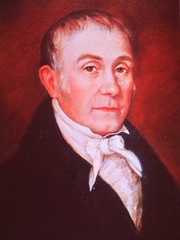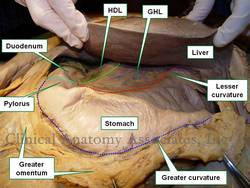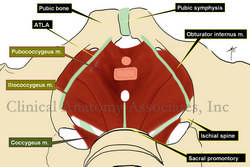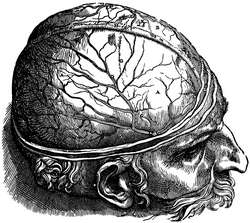
Medical Terminology Daily (MTD) is a blog sponsored by Clinical Anatomy Associates, Inc. as a service to the medical community. We post anatomical, medical or surgical terms, their meaning and usage, as well as biographical notes on anatomists, surgeons, and researchers through the ages. Be warned that some of the images used depict human anatomical specimens.
You are welcome to submit questions and suggestions using our "Contact Us" form. The information on this blog follows the terms on our "Privacy and Security Statement" and cannot be construed as medical guidance or instructions for treatment.
We have 354 guests online

Jean George Bachmann
(1877 – 1959)
French physician–physiologist whose experimental work in the early twentieth century provided the first clear functional description of a preferential interatrial conduction pathway. This structure, eponymically named “Bachmann’s bundle”, plays a central role in normal atrial activation and in the pathophysiology of interatrial block and atrial arrhythmias.
As a young man, Bachmann served as a merchant sailor, crossing the Atlantic multiple times. He emigrated to the United States in 1902 and earned his medical degree at the top of his class from Jefferson Medical College in Philadelphia in 1907. He stayed at this Medical College as a demonstrator and physiologist. In 1910, he joined Emory University in Atlanta. Between 1917 -1918 he served as a medical officer in the US Army. He retired from Emory in 1947 and continued his private medical practice until his death in 1959.
On the personal side, Bachmann was a man of many talents: a polyglot, he was fluent in German, French, Spanish and English. He was a chef in his own right and occasionally worked as a chef in international hotels. In fact, he paid his tuition at Jefferson Medical College, working both as a chef and as a language tutor.
The intrinsic cardiac conduction system was a major focus of cardiovascular research in the late nineteenth and early twentieth centuries. The atrioventricular (AV) node was discovered and described by Sunao Tawara and Karl Albert Aschoff in 1906, and the sinoatrial node by Arthur Keith and Martin Flack in 1907.
While the connections that distribute the electrical impulse from the AV node to the ventricles were known through the works of Wilhelm His Jr, in 1893 and Jan Evangelista Purkinje in 1839, the mechanism by which electrical impulses spread between the atria remained uncertain.
In 1916 Bachmann published a paper titled “The Inter-Auricular Time Interval” in the American Journal of Physiology. Bachmann measured activation times between the right and left atria and demonstrated that interruption of a distinct anterior interatrial muscular band resulted in delayed left atrial activation. He concluded that this band constituted the principal route for rapid interatrial conduction.
Subsequent anatomical and electrophysiological studies confirmed the importance of the structure described by Bachmann, which came to bear his name. Bachmann’s bundle is now recognized as a key determinant of atrial activation patterns, and its dysfunction is associated with interatrial block, atrial fibrillation, and abnormal P-wave morphology. His work remains foundational in both basic cardiac anatomy and clinical electrophysiology.
Sources and references
1. Bachmann G. “The inter-auricular time interval”. Am J Physiol. 1916;41:309–320.
2. Hurst JW. “Profiles in Cardiology: Jean George Bachmann (1877–1959)”. Clin Cardiol. 1987;10:185–187.
3. Lemery R, Guiraudon G, Veinot JP. “Anatomic description of Bachmann’s bundle and its relation to the atrial septum”. Am J Cardiol. 2003;91:148–152.
4. "Remembering the canonical discoverers of the core components of the mammalian cardiac conduction system: Keith and Flack, Aschoff and Tawara, His, and Purkinje" Icilio Cavero and Henry Holzgrefe Advances in Physiology Education 2022 46:4, 549-579.
5. Knol WG, de Vos CB, Crijns HJGM, et al. “The Bachmann bundle and interatrial conduction” Heart Rhythm. 2019;16:127–133.
6. “Iatrogenic biatrial flutter. The role of the Bachmann’s bundle” Constán E.; García F., Linde, A.. Complejo Hospitalario de Jaén, Jaén. Spain
7. Keith A, Flack M. The form and nature of the muscular connections between the primary divisions of the vertebrate heart. J Anat Physiol 41: 172–189, 1907.
"Clinical Anatomy Associates, Inc., and the contributors of "Medical Terminology Daily" wish to thank all individuals who donate their bodies and tissues for the advancement of education and research”.
Click here for more information
- Details
The [pubococcygeus muscle] is one of the muscles that forms the pelvic diaphragm. It is the deepest and one of the two muscular components of the levator ani muscle, the other one being the iliococcygeus muscle.
The pubococcygeus muscle attaches anteriorly to the posterior aspect of the body of the os pubis or pubic bone, leaving a gap or hiatus anteriorly which allows passageway of the deep dorsal vein of the penis in the male or the deep dorsal vein of the clitoris in the female.
Anterolaterally, the pubococcygeus muscle attaches to a thickening of the deep fascia of the obturator internus muscle called the Arcus Tendineous Levator Ani (ATLA).
As its name implies, the pubococcygeus attaches posteriorly to the sacrococcygeal region and posteromedially it attaches to a medial ligamentous structure that stretches between the anal canal and the coccyx, the anococcygeal ligament or anococcygeal raphe.
Several subcomponents are described in the pubococcygeus muscle, one of them being the puborectalis muscle. This muscle is the medial component of the pubococcygeus, it attaches anteriorly to the pubic bone and arches posterior to the anal canal, kinking it and being one of the components of fecal continence.
- Details
Dura Mater: Latin terms meaning [tough mother]. The dura mater is the outermost of the three meninges. It is quite tough, forming a sac containing the spinal cord and brain, known as the dural sac or thecal sac. The image, from a book by Andreas Vesalius, shows a head with the dura mater in situ (label "A").
For more information on the meninges, click here.
Original images from Andreas Vesalius '"De Humani Corporis Fabrica; Libri Septem" (1543)
- Details
This suffix [-(o)centesis] arises from the Greek [kentesis], meaning "to tap" or "to perforate", referring to a needle or trocar. In practical terms, this suffix means "needle aspiration of". Examples of its use are:
- Pericardiocenteses: Needle aspiration of the pericardium
- Thoracocentesis: Needle aspiration of the thorax. The use of the term "thoracentesis" is wrong!
- Amniocentesis: Needle aspiration of the amniotic sac
- Arthrocentesis: Needle aspiration of a joint
- Details
This article is part of the series "A Moment in History" where we honor those who have contributed to the growth of medical knowledge in the areas of anatomy, medicine, surgery, and medical research.

Ephraim McDowell
Ephraim McDowell (1771- 1830). American surgeon, Ephraim McDowell was born in 1771 in the Augusta County of Virginia. His family moved to the “frontier”, which at that time was Kentucky, where his father was a judge. McDowell studied in Kentucky and returned to Virginia to serve as an apprentice to Dr. Alexander Humphreys. Following Dr. Humphrey’s advice McDowell went to Edinburgh to finish his formal medical training, which he did not finish, taking chemistry, anatomy, and then a private medical course with Dr. John Bell.
Returning to America, he settled in the Ohio River Valley, and had a successful practice as a frontier surgeon in the city of Danville, Kentucky. This was before the advent of anesthesia and antisepsis.
On Christmas Day 1809, Dr. McDowell performed the first recorded ovariotomy to drain a massive ovarian cyst from Mrs. Mary Jane Crawford, who had to ride a horse for sixty miles to get to Dr. McDowell’s office where he performed the ovariotomy without anesthesia. Mrs. Crawford had been diagnosed as “pregnant” by two other physicians. Dr. McDowell’s hand-written report states that he performed a nine-inch abdominal incision, the operation lasted about twenty five minutes, and they removed “fifteen pounds of a dirty gelatinous substance” and “extracted the sac, which weighed seven and a half pounds”.
Mrs. Crawford survived the operation, was ambulatory in five days, and lived for 33 additional years, until she was 78 years old. Research has been made as to the reason for the survival at a time when the norm for an operation that penetrated the peritoneal cavity was death. Othersen (2004) states that his research indicated that Dr. McDowell was “meticulous, neat and scrupulously clean”.
Because of the times, and because Dr. McDowell was not into writing, the achievement was not known for many years, until 1817. Dr. McDowell later performed a lithotomy on James Polk, who would eventually become president of the United States. In 1825, his achievements were recognized and he received an honorary MD degree by the University of Maryland.
Dr. McDowell’s house in Danville, KY is today a museum, and his name is remembered by the “Ephraim McDowell Health System” a group of integrated healthcare based in the same city. For more information on Mary Jane Crawford, click here.
PERSONAL NOTE: On February 19, 2017 I was able to go visit this place. Click here for a series of articles and pictures of this visit. Dr. Miranda
Sources:
1. “Ephraim McDowell (1771-1830) Kentucky Surgeon” JAMA. 1963;186 (9):861-862
2. “Ephraim McDowell: The Qualities of a Good Surgeon” Othersen, HB Ann Surg. 2004; 239(5): 648–650
3. “Ephraim McDowell (1771-1830): pioneer of ovariotomy” Tan,SY & Wong, C. Singapore Med J 2005; 46(1) : 4
4. “Ephraim McDowell, the First Ovariotomy, and the Birth of Abdominal Surgery” Horn, L and Johnson, DH. J Clin Onco 2010: 28; 7 1262-1268
5. "Surgeon of the wilderness: Ephraim McDowell" Haggard, WD. Presidential Address, ACS 1933. FACS archives 1934, 58: 415-4198
Image in Public Domain. Courtesy of the National Library of Medicine.
- Details

Anteroinferior view of the liver and stomach
The [lesser omentum] is a double-layered peritoneal membrane found between the stomach and the first portion of the duodenum and the liver.
Between the two layers of the lesser omentum there is a small amount of fat, the coronary vein, the arteries of the lesser curvature vascular arcade, the gastroduodenal artery, and the structures of the portal triad: Portal vein, common bile duct, and proper hepatic artery.
The lesser omentum is divided into two subcomponents:
- The gastrohepatic ligament, the larger component, found between the lesser curvature and the liver. It includes the pylorus.
- The gastroduodenal ligament, the smaller component, found between the first portion of the duodenum (superior portion, duodenal ampulla) and the liver. The common bile duct is found between the layers of the omentum.
Image property of: CAA.Inc. Photographer: David M. Klein
- Details
The word [celiac] is the American version of the more internationally used term [cæliac]. It derives from the New Latin word [c?liacus] which means "pertaining to the bowels". This term in turn arises from an older Greek term [koilus] which means "hollow", "cave", or "cavity". By extension the words celiac or cæliac have come to mean "pertaining to the abdominal cavity".
In embryology, the term [celomic cavity] (a redundancy) is used to denote the combined abdominal and thoracic cavities in the embryo before the respiratory diaphragm separates these two into two separate bodily cavities.
The term [celiac] is used in other words such as:
- Celiac trunk: one of the unpaired branches of the abdominal aorta
- Celiac disease: an abdominal pathology characterized by distention and retention
- Celiac plexus: a plexus of autonomic nerves found around the celiac trunk.



